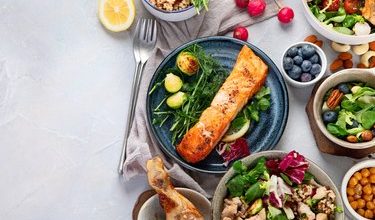Why Cooking Meals at Home Benefits More Than Just Your Wallet

Peopleimages/E+/GettyImages
After a long day at work, the last thing you probably want to do is slave over a stove. And when hunger strikes, the convenience of pulling into a fast food drive-thru or ordering takeout can be terribly tempting.
Relying on food away from home is totally acceptable once in a blue moon, but when it becomes a routine, your waistline, your wallet and your health can take a hit. Here are six reasons to make cooking at home your default.
Video of the Day
Video of the Day
1. It May Reduce Your Exposure to Certain Chemicals
The most surprising benefit of cooking at home? It can decrease the amount of harmful chemicals you’re exposed to. People who prepared more home-cooked meals have lower levels of dangerous chemicals called per- and polyfluoroalkyl substances (PFAS) in their bodies, according to research published in the October 2019 issue of Environmental Health Perspectives.
Common in take-out and fast-food packaging (and even those compostable bowls popping up everywhere), PFAS have been associated with cancer, thyroid disease, immune suppression, low birth weight and decreased fertility, according to Mandy Enright, RDN.
But that’s not all. Food packaging can also contain other damaging compounds, like BPA and phthalates, which are known hormone-disruptors.
2. It’s Cheaper
Americans spend more money dining out than they do on foods prepared at home, according to a 2018 report by the U.S. Department of Agriculture (USDA). Think of it this way: You could splurge upwards of $100 at a fancy restaurant for one dinner, while the same amount of money could buy you groceries for a week.
And, when you shop smart and get creative, you don’t need to spend more than $1 on breakfast, $2 on lunch and $4 on dinner to purchase wholesome, healthy foods, Bonnie Taub-Dix, RDN, creator of BetterThanDieting.com and author of Read It Before You Eat It : Taking You from Label to Table, tells LIVESTRONG.com.
Here’s how: Buy in bulk, and stick to store-brand items. A family pack of chicken, bulk-sized bags of potatoes and generic frozen veggies help pave the way to savings, says Taub-Dix.
3. You Can Better Estimate Calories
Eating out can make calorie counting tricky, which is why people tend to consume an extra 200 calories when dining away from home, according to a November 2014 study published in Public Health Nutrition.
Conversely, when you cook in your own kitchen, you have complete control over the ingredients. Choosing fiber-packed veggies and leaner cuts of meat will help keep your calories (and your saturated fat intake) in check, says Enright. So will the way you cook your food. Rather than frying, opt to grill, roast or broil. For example, you can cut the calories in a meal like chicken parmesan by using grilled chicken breasts instead of fried chicken cutlets.
4. You Can Control Portion Sizes
When dining out, people tend to lick their plates clean. In part, that’s due to the “I paid for it, so I have to finish it” mentality, says Taub-Dix. The problem? Restaurant portions have doubled in the last 20 years, according to the National Heart, Lung, and Blood Institute. And in fact, a serving of french fries is nearly three times bigger than it was two decades ago. In other words, if you finish your meal, you might’ve eaten enough for three people!
At home, you’re in charge of the portion sizes. Enright recommends plating your meals according to the USDA’s dietary guidelines: Fill half your dish with veggies and fruits, and divide the other half equally between lean proteins and whole grains. And keep extra helpings of food off the table while you eat, so you won’t be tempted to pick and overindulge, says Enright, who also suggests wrapping up leftovers ASAP and packing them for tomorrow’s healthy lunch.
5. You Can Slash Added Salt and Sugar
“Many chefs sprinkle salt on their food like they’re throwing out feed to chickens on a farm,” says Taub-Dix. That is to say, they use a heck of a lot of it. But while salt can make food tastier, too much of it is linked to serious health issues like heart disease, high blood pressure and stroke.
At home, you can control the amount of sodium on your plate by seasoning food in other ways, like using lemon juice and incorporating blends of your own herbs and spices.
The same goes for sugar, says Enright. You can use smaller quantities of natural sweeteners like honey or maple syrup, or swap in higher-fiber ingredients like prunes and applesauce to lend sweetness to your food without the added sugar (too much of which is linked to obesity, diabetes and heart disease).
Keeping tabs on your sugar and salt intake is especially important for people with conditions like diabetes and hypertension.
6. You Can Limit Saturated Fats
If you’re trying to stick to a diet low in saturated fat, dining out can be problematic. That’s because many restaurants use high-fat butters and oils for flavor, says Taub-Dix, adding that a cup of oil runs around 2,000 calories. So, how much of that oil — and all the residual stuff that accumulates on the grill and in the pan throughout the day — gets absorbed by your food? Who knows, but odds are that it’s quite a bit.
Cooking at home takes the guesswork out of the equation. You can choose options that are higher in healthy fats like olive oils, avocado oils and flaxseed oils, says Enright. Plus, you can carefully measure out appropriate amounts. This way, you know exactly what’s going on your plate and into your body.
Tips for Healthy Cooking
Ready to get busy in the kitchen? Here, Taub-Dix and Enright offer pointers to help you kickstart — or upgrade — a healthy at-home cooking routine.
Prepare a weekly meal plan on Sunday. Select three simple recipes to make for the workweek, with the intention of having leftovers to use for additional meals. Then create your grocery list and shop for only those ingredients. This will help you save money and avoid buying unnecessary — and potentially unhealthy — items.
You don’t have to make everything from scratch. Buy a BBQ chicken, boil a handful of whole-grain pasta and sauté some veggies (fresh or frozen). You can throw this dish together in minutes. In that vein, make your life simpler by opting for pre-washed, pre-cut veggies (or stock up on frozen veggies).
On nights you don’t feel like cooking, eat breakfast for dinner. Toss together a medley of wholesome cereals, nuts and fruit. Cereals can provide a wealth of nutrients, like fiber (60 percent of your daily value in Fiber One), iron (79 percent of your daily requirement in Wheat Chex) and folic acid (50 percent of your daily need in Wheaties).




